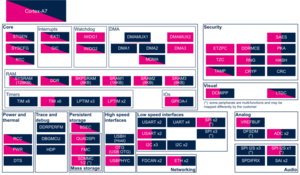1. Article purpose[edit | edit source]
The purpose of this article is to:
- briefly introduce the MDMA peripheral and its main features,
- indicate the peripheral instances assignment at boot time and their assignment at runtime (including whether instances can be allocated to secure contexts),
- list the software frameworks and drivers managing the peripheral,
- explain how to configure the peripheral.
2. Peripheral overview[edit | edit source]
The MDMA peripheral is used to perform high-speed data transfers between memory and memory or between peripherals and memory. The MDMA controller offers 32 channels. The selection of the device connected to each channel and controlling DMA transfers is done in MDMA peripheral.
Among all the requestor lines described in the reference manual, DMA channels are the only lines that allow to perform transfers with chained DMA and MDMA (refer to DMA internal peripheral article). As a result, when a device is not connected to the MDMA, it is anyway possible to operate in DMA mode via the DMA controller and chain DMA and MDMA.
The MDMA is a secure peripheral. This means that it performs each transfer in the context of the master that requested it:
- a transfer requested by the Arm® Cortex®-A7 non-secure core propagates non-secure accesses to the targeted device and/or memory.
- a transfer requested by Arm Cortex-A7 secure core propagates secure accesses to the targeted device and/or memory.
Refer to the STM32 MPU reference manuals for the complete list of features, and to the software frameworks and drivers, introduced below, to see which features are implemented.
3. Peripheral usage[edit | edit source]
This chapter is applicable in the scope of the OpenSTLinux BSP running on the Arm® Cortex®-A processor(s), and the STM32CubeMPU Package running on the Arm® Cortex®-M processor.
3.1. Boot time assignment[edit | edit source]
The MDMA peripheral is not used at boot time.
3.2. Runtime assignment[edit | edit source]
3.2.1. On STM32MP13x lines  [edit | edit source]
[edit | edit source]
Click on ![]() to expand or collapse the legend...
to expand or collapse the legend...
Check boxes illustrate the possible peripheral allocations supported by the OpenSTLinux BSP:
- ⬚ means that the peripheral can be assigned to the given runtime context, but this configuration is not supported in OpenSTLinux BSP.
- ☐ means that the peripheral can be assigned to the given runtime context.
- ☑ means that the peripheral is assigned by default to the given runtime context and that the peripheral is mandatory for the OpenSTLinux BSP.
- ✓ is used for system peripherals that cannot be unchecked because they are hardware connected in the device.
Refer to How to assign an internal peripheral to an execution context for more information on how to assign peripherals manually or via STM32CubeMX.
The present chapter describes STMicroelectronics recommendations or choice of implementation. Additional possibilities might be described in STM32MP13 reference manuals.
| Domain | Peripheral | Runtime allocation | Comment | ||
|---|---|---|---|---|---|
| Instance | Cortex-A7 secure (OP-TEE) |
Cortex-A7 nonsecure (Linux) | |||
| Core/DMA | MDMA | MDMA | ⬚ | ☐ | Shareable (multiple choices supported) |
3.2.2. On STM32MP15x lines  [edit | edit source]
[edit | edit source]
Click on ![]() to expand or collapse the legend...
to expand or collapse the legend...
Check boxes illustrate the possible peripheral allocations supported by the OpenSTLinux BSP:
- ⬚ means that the peripheral can be assigned to the given runtime context, but this configuration is not supported in OpenSTLinux BSP.
- ☐ means that the peripheral can be assigned to the given runtime context.
- ☑ means that the peripheral is assigned by default to the given runtime context and that the peripheral is mandatory for the OpenSTLinux BSP.
- ✓ is used for system peripherals that cannot be unchecked because they are hardware connected in the device.
Refer to How to assign an internal peripheral to an execution context for more information on how to assign peripherals manually or via STM32CubeMX.
The present chapter describes STMicroelectronics recommendations or choice of implementation. Additional possiblities might be described in STM32MP15 reference manuals.
| Domain | Peripheral | Runtime allocation | Comment | |||
|---|---|---|---|---|---|---|
| Instance | Cortex-A7 secure (OP-TEE) |
Cortex-A7 nonsecure (Linux) |
Cortex-M4 (STM32Cube) | |||
| Core/DMA | MDMA | MDMA | ⬚ | ☐ | Shareable (multiple choices supported) | |
4. Software frameworks and drivers[edit | edit source]
Below are listed the software frameworks and drivers managing the MDMA peripheral for the embedded software components listed in the above tables.
- Linux®: dmaengine framework
STM32CubeMX allows to distinguish between non-secure and secure channels, among all the available channels.
On STM32MP15x lines ![]() , the MDMA is visible from the Arm Cortex-M4 core. However, it is not supported in this context by STM32MPU Embedded Software distribution.
, the MDMA is visible from the Arm Cortex-M4 core. However, it is not supported in this context by STM32MPU Embedded Software distribution.
5. How to assign and configure the peripheral[edit | edit source]
The peripheral assignment can be done via the STM32CubeMX graphical tool (and manually completed if needed).
This tool also helps to configure the peripheral:
- partial device trees (pin control and clock tree) generation for the OpenSTLinux software components,
- HAL initialization code generation for the STM32CubeMPU Package.
The configuration is applied by the firmware running in the context in which the peripheral is assigned.

